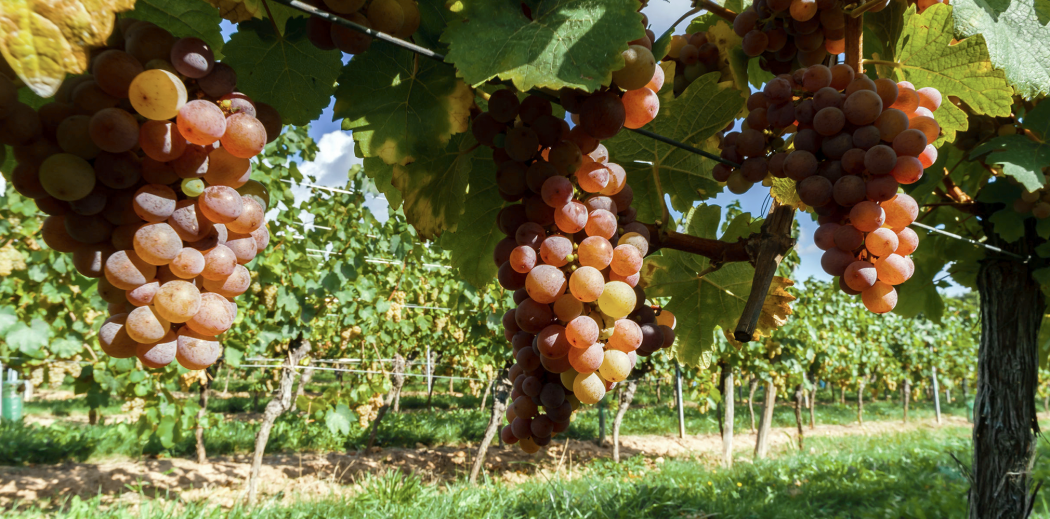There are few things more terrifying than trying to order a wine that you can’t pronounce. However, if you ever see Gewürztraminer on a menu, don’t let the onslaught of letters and umlauts make you miss out on this aromatic French wine.
Meet Gewürztraminer
Pink- and red-skinned Gewürztraminer (pronounced geh-VERTZ-trah-mee-nur) originated in Germany but has since achieved success throughout Europe, particularly in Alsace, where it’s one of the four Grand Cru grapes. While it might be unfamiliar to the casual drinker, it’s now considered one of the 18 noble grapes, meaning it’s generally regarded as some of the best white vino in the world. For good reason.
Imagine a more refined Moscato, but up the alcohol content and lower the acidity and you’ve got Gewürztraminer, which falls on the sweet end of the spectrum without being too sugary. The overwhelming note is lychee – the fruit and the grape actually share aromatic compounds – with hints of rose and ginger. The more ripe the grape, the more pineapple tastes will come through, and expect a slightly bitter aftertaste no matter how long the fruit’s been on the vine.
If you don’t have a sweet tooth, that doesn’t mean you should avoid Gewürztraminer completely. As an aromatic grape, its sweet smell and taste can be deceiving. Some bottles only have one to two residual grams of sugar (RS), equivalent to what you’d find in a dry white.
And it gets better. Since Gewürztraminer isn’t a household name, you can grab a great bottle for under $20, and some good bottles for close to $10. While it’s disappointing great varietals don’t always get the recognition they deserve, the ensuing affordability is the benefit of keeping them a secret.
A Complicated History
Gewürztraminer translates to “Spice Traminer” or “Perfumed Traminer,” pointing to its place in the Traminer family. The Traminer grape, named after Tramin, Italy, was green-skinned and often synonymous with Savagnin blanc (not to be confused with Sauvignon Blanc), though whether they’re interchangeable has now been thrown into question. Regardless, the grape mutated into variations with pink skin, dubbed Red Traminer or Savagnin Rose, later mutating into the sweeter Gewürztraminer.
Its primary location in Alsace, near the French-German border, muddled its classification during the continuous European wars. In this case, wine of the same name doesn’t always taste as sweet, possibly because Gewürztraminer from different regions are other varietals that have become mislabeled. Bottles from Germany tend to be less aromatic than those from Alsace as some believe Germany’s are really Savagnin Rose.
Thanks to this confusion and how influenced Gewürztraminer is by terroir, picking the right bottle that meets your dry or dessert preferences requires being familiar with major growing areas. But first, you’ll have to find a bottle, which might be easier said than done. There are only about 35,000 acres worldwide (compare this to over 500,000 for Chardonnay) that grow Gewürztraminer, with the majority in Alsace and the US.
A brief cheat-sheet: Alsace is going to produce the typical Gewürztraminer, loaded with lychee, rose, and fruit. Italy, particularly the Trentino-Alto Adige region, yields much drier wines. Bottles from California and Washington state tend to err on the sweeter side.
Raise a Glass
Drink it straight, or pair it with Middle Eastern and Moroccan meals as the wine can hold its own against spicy and rich dishes. It pairs particularly well with dried fruit and ginger, and Vendage Tardives, or late harvest Gewürztraminer, is a deep, spicy dessert wine.
Next time you’re looking for something sweeter, ditch the Moscato and Reisling and source out a bottle of Gewürztraminer – you’ll impress everyone with your selection that no one will care how you pronounce it.








